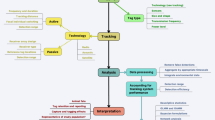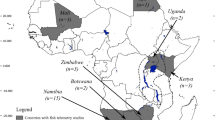Abstract
Fisheries management is a crucial issue worldwide, but it is proportionally more crucial in developing countries that rely heavily on inland fisheries. Management requires proper knowledge of fish behaviour and habitat use, as can be achieved through telemetry techniques, although these are most rarely used in tropical regions. Here we report briefly on the outcomes of a pilot workshop and training course aiming at improving technology transfer and capacity building, laying the stress on strengths and weaknesses of this approach, as evaluated by trainees.
Similar content being viewed by others
References
Baras, E. & M. C. Lucas, 2002. Impacts of man's modifications of river hydrology on the migration of freshwater fishes: a mechanistic perspective. Ecohydrol. Hydrobiol. 1: 291-304.
Baras, E., B. Togola, B. Sicard & V. Bénech, 2002. Behaviour of tigerfish Hydrocynus brevis in the River Niger, Mali, as revealed by simultaneous telemetry of activity and swimming depth. Hydrobiologia 483/Dev. Hydrobiol. 165: 103-110.
FAO, 1995. Code of Conduct for Responsible Fisheries. FAO, Rome.
FAO, 1999. Review of the state of world fishery resources: inland fisheries. FAO Fish. Circ. 942, FAO, Rome.
FAO, 2001. Rapport de l'atelier pilote sur l'application de la biotélémétrie à l'étude des poissons pour la gestion des pêches continentales en Afrique de l'Ouest. FAO Fish. Rep. 654, FAO, Rome.
Hocutt, C. H., 1989. Seasonal and diel behaviour of radio-tagged Clarias gariepinus in lake Ngezi, Zimbabwe (Pisces, Clariidae). J. Zool. (London) 219: 181-199.
Hocutt, C. H., S. E. Seibold & R. V. Jeisen, 1994. Potential use of biotelemetry in tropical continental waters. Rev. Hydrobiol. Trop. 27: 77-95.
Lucas, M. C. & E. Baras, 2000. Methods for studying spatial behaviour of freshwater fishes in the natural environment. Fish Fish. 1: 283-316.
Lucas, M. C. & E. Baras, 2001. Migration of Freshwater Fishes. Fishing News Books, Blackwell Science Ltd, Oxford: 420 pp.
Marmulla, G. & V. Bénech, 2000. Necessity for an exchange network for fisheries projects using biotelemetry in developing countries. In Moore, A. & I. C. Russell (eds), Advances in Fish Telemetry. CEFAS, Lowestoft: 197-205.
Økland, F., T. F. Næsje & E. B. Thorstad, 2000. Movements and habitat utilisation of cichlids in the Zambezi River, Namibia. A radio telemetry study in 1999-2000. NINA-NIKU (Trondheim) Project Report 011: 1-25.
Welcomme, R. L., 1985. River fisheries. FAO Fish. Tech. Pap. 262: 1-330.
Welcomme, R. L., 2001. Inland fisheries. Ecology and Management. FAO and Fishing News Books, Blackwell Science Ltd, Oxford: 358 pp.
Author information
Authors and Affiliations
Rights and permissions
About this article
Cite this article
Baras, E., Bénech, V. & Marmulla, G. Outcomes of a pilot fish telemetry workshop for developing countries. Hydrobiologia 483, 9–11 (2002). https://doi.org/10.1023/A:1021382201886
Issue Date:
DOI: https://doi.org/10.1023/A:1021382201886




